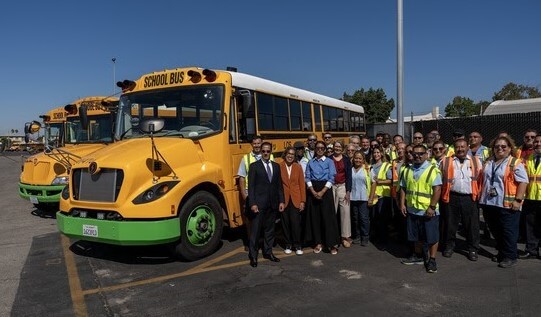California is launching a new statewide funding program that will put 1,000 new, zero-emission school buses on the road, furthering the state’s lead in having the largest number of clean buses in the nation.
“California is showing the nation and the world how to move from ambition to action,” says Gov. Gavin Newsom. “This is yet another record state investment that puts the health of our kids and communities first — replacing 1,000 older polluting school buses with clean buses.”
The program will distribute $500 million to school districts and other educational entities to replace aging school buses with zero-emission vehicles and purchase needed infrastructure. The Zero-Emissions School Bus and Infrastructure (ZESBI) program is accepting funding applications through Sept. 30.
As California continues to lead in the deployment of zero-emission vehicles and in building the necessary infrastructure, the focus on school buses targets a sector where the switch to cleaner technology will lead to better public health outcomes for schoolchildren and the communities where they live.
The program is a collaboration between the California Air Resources Board (CARB) and the California Energy Commission (CEC), and is administered by CALSTART, a transportation nonprofit.
“Children are especially vulnerable to the impacts of diesel pollution, so transitioning to clean school buses is key to protecting our kids’ health while getting them to school safely,” says CARB Chair Liane Randolph. “The investments that California is making in zero-emission school bus technology will pay off in cleaner air, modernized fleets for our schools and healthier communities.”
Zero-emission school buses play a key role in California’s efforts to achieve carbon neutrality by 2045 and help protect children who are particularly vulnerable to the health impacts from diesel exhaust. In California, all school bus purchases made by school districts will need to be zero-emission technology by 2035, with an extension until 2040 for school districts in rural communities.
The time children spend in school bus commutes accounts for less than 10% of a child’s day, yet the commutes have been found to contribute up to 33% of a child’s daily exposure to some air pollutants, according to a study funded by CARB.
To date, California has provided more than $1.3 billion in incentives to school districts that have funded more than 2,300 zero-emission school buses, of which 1,100 are already in use. Over 70% of the zero-emission buses in operation are in the state’s most pollution-burdened communities. More than 300 California school districts and local education agencies have purchased at least one zero-emission bus — and a few have made the switch to a 100% clean fleet.
Awardees can receive up to $375,000 to replace internal combustion engine school buses with zero-emission vehicles, as well as awards up to $95,000 per school bus to purchase and install associated charging infrastructure. Awardees will be required to scrap an old school bus for every new bus purchased.
Priority for the funding will be given to small or rural school districts, as well as local educational agencies that have a large proportion of students who receive free or reduced-price meals, are in foster care, or are English-language learners. Local educational agencies located in low-income or disadvantaged communities will receive secondary priority.
Eligible applicants include:
- Public school districts
- Public charter schools
- Joint power authorities
- County offices of education
Applicants should be prepared to provide the following at the time of application:
- Letter of intent
- A copy of the California Department of Motor Vehicles registration for each old school bus that they plan to scrap
- A copy of a current California Highway Patrol Safety Certification (CHP 292)
- Preliminary information regarding existing and planned charging infrastructure







